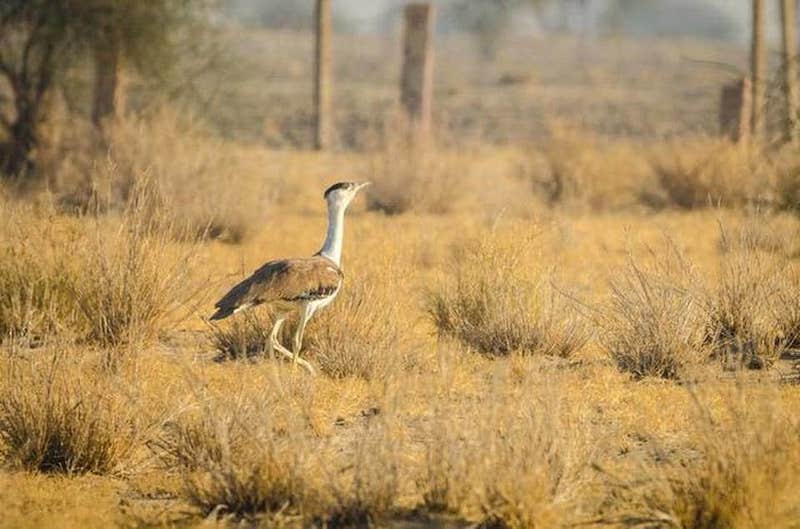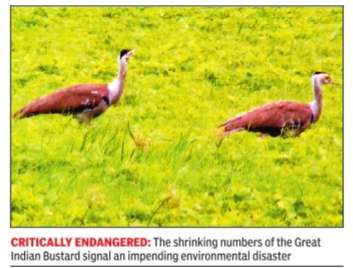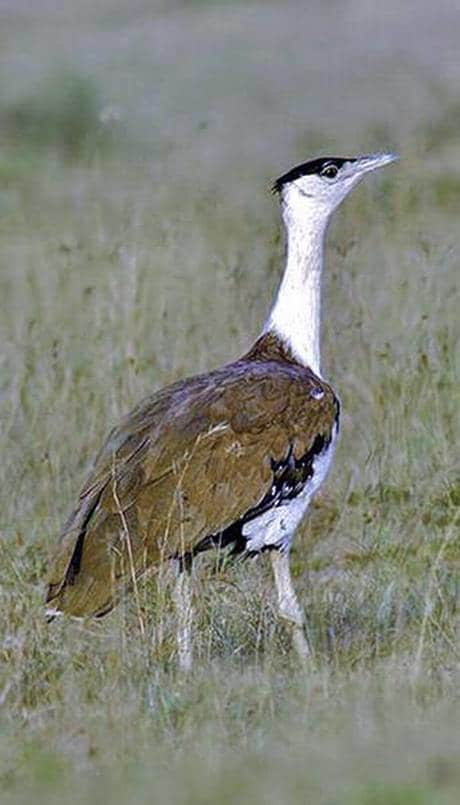Great Indian Bustard
(→Status, In brief) |
|||
| Line 9: | Line 9: | ||
[[Category:India |B ]] | [[Category:India |B ]] | ||
[[Category:Fauna |B ]] | [[Category:Fauna |B ]] | ||
| + | [[Category:Pakistan |B ]] | ||
=Characteristics= | =Characteristics= | ||
Revision as of 07:17, 19 January 2019
This is a collection of articles archived for the excellence of their content. |
Contents |
Characteristics
The great Indian bustard can easily be distinguished by its black crown on the forehead contrasting with the pale neck and head. The body is brownish and the wings are marked with black, brown and grey. Males and females generally grow to the same height and weight but males have larger black crowns and a black band across the breast. They breed mostly during the monsoon season when females lay a single egg on open ground. Males have a gular pouch, which helps produce a resonant booming mating call to attract females and can be heard up to a distance of 500 metres. Males play no role in the incubation and care of the young, which remain with the mother till the next breeding season. These birds are opportunist eaters. Their diet ranges widely depending on the seasonal availability of food. They feed on grass seeds, insects like grasshoppers and beetles, and sometimes even small rodents and reptiles.
Location
Shrishtee Bajpai, January 17, 2019: The Hindu

From: Shrishtee Bajpai, January 17, 2019: The Hindu
The GIB prefers grasslands ecosystem to survive (the most threatened and neglected ecosystem). But, their primary habitat is being diverted for industries, mining, and intensive agricultural practices. With a meagre population of 150 GIB’s remaining, we must act urgently to protect their habitat — the grasslands.
Rajasthan: Desert National Park
Shrishtee Bajpai, January 17, 2019: The Hindu
The Great Indian Bustard is one of the heaviest flying birds. Sadly, it is now on the endangered list as more and more of its habitat is disappearing.
A desert teeming with wildlife, including a bird almost as tall as a human? I could never imagine this, till I got the chance to go to Desert National Park near Jaisalmer, Rajasthan. Spread over 3000 sq km, this Park hosts one of the heaviest flying birds in the world — the endangered Great Indian Bustard (GIB), besides other wild animals.
It was my first visit to a desert ecosystem, full of sand and stones. Incredibly, this National Park has fossil evidence dating back to the Jurassic Period (180 million years ago) when it apparently had a hot and humid climate characterised by dense forests … so different from now!
After almost missing on sighting the desert cat, we were more alert when it came to look for the GIB. Meanwhile, we came across many raptors (birds of prey) perched on distant trees or soaring above us.
A sighting
Back in our guest house before the evening safari, our afternoon rest was pleasantly interrupted when a friend signalled to come out and pointed to a spiny-tailed lizard feeding on the shrubs. We noticed its stout tail with numerous protective spines. In a couple of minutes, it became aware of us and quickly ran into its burrow, a hole in the sand. We kept waiting for Mr. Spiny to come out but it wasn’t in the mood. Locally called sanda, they are significant prey for mammals and many raptors. However, due to excessive poaching (some people think their oil has medicinal properties!) they are threatened.
Even after such extraordinary sightings, we were looking forward to spotting the GIB. It was almost at the end of our evening safari and we had heard enough bustard tales, but had as yet no sighting. I was quite anxious, imagining how I should position my camera that I could get the best shot of this shy bird. All of us were distracted when our guide whispered ‘bustard’. Sure enough, we sighted one but as we got close, it flew away before I could take a picture. Our return to the rest house was filled with high anticipation as we hoped to spot another GIB. Unfortunately, it did not happen. But, I was still happy to get a glimpse of a species that might be the next bird on the list to become extinct in India.
Population
2014: less than 200
Great Indian Bustard flying into extinction
Saswati Mukherjee The Times of India Nov 17 2014 Bengaluru:

From: Saswati Mukherjee The Times of India Nov 17 2014
RAMPANT POACHING & HABITAT LOSS MAKE BIRDS VANISH FROM COUNTRY
Less Than 200 Left, Figure In Endangered List
The majestic Great Indian Bustards (GIBs) are vanishing from sight and their dwindling numbers have put them in the International Union for Conservation of Nature’s (IUCN) critically endangered category (red list). According to estimates, less than 200 GIBs are left in the country now.
A huge bird with a horizontal body and long, bare legs, the GIB looks like an ostrich. Among the heaviest of flying birds, they were once endemic to the dry plains of India, abundantly found in the Ranebennur region of central Karnataka. Their population has dwindled significantly because of habitat loss and rampant poaching.
“GIBs are shrinking by the day; their count has fallen below the 200 mark,” says Mohammed Esmail Dilawar, president and founder, Nature Forever Society, Maharashtra.
S Subramanya, scientist and senior faculty member at University of Agricultural Sciences (UAS), says: “Grasslands in the state are being converted to agriculturally fit land and pressure from real-estate development is immense too. Habitat loss is the obvious consequence.” Experts say a vibrant GIB population is reflective of a healthy ecosystem. The bird’s shrinking numbers signal an impending environmental disaster, they warn. “GIBs are an indicator of a healthy grassland ecosystem,” says Sujit Narwade, project scientist, Bombay Natural History Society. “Grasslands as a forest category support biodiversity dependent on it, ranging from termites and spiders to insects and wolves. Unfortunately, they are usually considered wastelands. Many species exist in the food web and food chain in grassland ecosystems. If one is allowed to vanish, other species too will unknowingly disappear.” Maharashtra, Andhra Pradesh and Karnataka have an estimated population of 10-15 birds each; they can still be spotted in the existing bustard ranges. Gujarat and Rajasthan support a higher number of bustards.
In 2012, the drastic fall in the population of Indian bustards, their endangered status and the decline of grasslands prompted the ministry of environment and forests to draft a species recovery programme for them. Each bustard range state developed site-specific conservation plans, but their implementation has floundered, including of the one in Karnataka.
2019/ 50 left in the wild

From: Mohammed Iqbal, Only 50 Great Indian Bustards left in the wild, no action on plan to save them, January 18, 2019: The Hindu
Almost two years after the Rajasthan government proposed setting up of captive breeding centres for the Great Indian Bustards to boost their wild population, the wildlife activists here have called for enforcement of recovery plan for the country’s most critically endangered bird. The GIB’s last remnant wild population of about 50 in Jaisalmer district accounts for 95% of its total world population.
No progress has been made on the proposal for establishing a captive breeding centre at Sorsan in Kota district and a hatchery in Jaisalmer’s Mokhala village for conservation of the State bird of Rajasthan. The previous BJP regime had taken up the work in 2017 after the Union Ministry of Environment, Forest and Climate Change sanctioned ₹33.85 crore to facilitate the two centres and authorised the Wildlife Institute of India to be its scientific arm.
A group of wildlife activists, who met Rajasthan Minister of State for Environment & Forest Sukh Ram Bishnoi, offered to formulate an emergency action plan for conservation of GIB in order to help the State government tackle the issue methodically.
Tourism & Wildlife Society of Indian honorary secretary Harsh Vardhan, who was among those who met Mr. Bishnoi, said the decisions after the launch of the Project Bustard in 2013 had not been followed up for five years. “The forest officers have concentrated solely on tiger, which has done well. The tiger population is settling outside the Ranthambhore reserve... Two females recently gave litters in scrub areas dominated by human settlements,” he said.
Other members of the group were Sariska Foundation secretary Dinesh Durrani and former Chief Wildlife Warden R.N. Mehrotra.
The group pointed out that the WII had not nominated any scientist to work exclusively on GIB in the State despite the related issues discussed at a meeting held here in April 2017 to decide for setting up the conservation breeding centres. “No progress has been made on land allotment or deputing a scientists abroad to get the breeding training,” the members told the Minister.
Incubation unit
Mr. Vardhan said the group had suggested to the Minister that an incubation unit be set up at Jaisalmer district’s Sudasri — considered the sanctum sanctorum of the Desert National Park — so as to step up recruitment rate of the critically endangered species. “This can be done within a few weeks, whereas the breeding centres will take time,” he said.
Mr. Bishnoi told the group that he would visit the DNP after the ongoing session of the State Assembly was over and convene a meeting of WII, forest officers and wildlife activists to take the GIB programme forward. He agreed that the endangered bird should get the highest priority in the conservation plans.
Status
Listed in Schedule I of the Indian Wildlife (Protection)Act, 1972, in the CMS Convention and in Appendix I of CITES, as Critically Endangered on the IUCN Red List and the National Wildlife Action Plan (2002-2016). It has also been identified as one of the species for the recovery programme under the Integrated Development of Wildlife Habitats of the Ministry of Environment and Forests, Government of India.
Threats
The biggest threat to this species is hunting, which is still prevalent in Pakistan. This is followed by occasional poaching outside Protected Areas, collisions with high tension electric wires, fast moving vehicles and free-ranging dogs in villages. Other threats include habitat loss and alteration as a result of widespread agricultural expansion and mechanized farming, infrastructural development such as irrigation, roads, electric poles, as well as mining and industrialization.